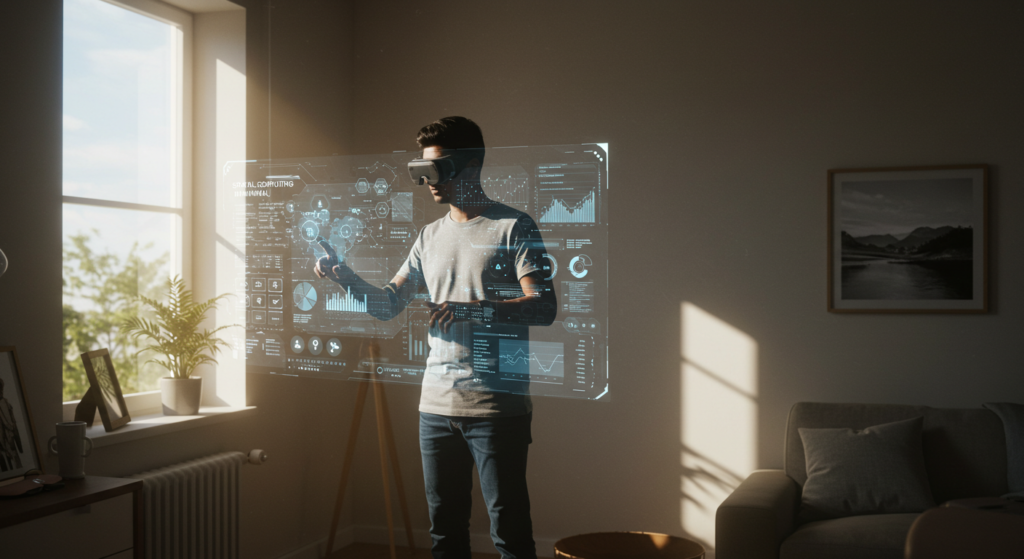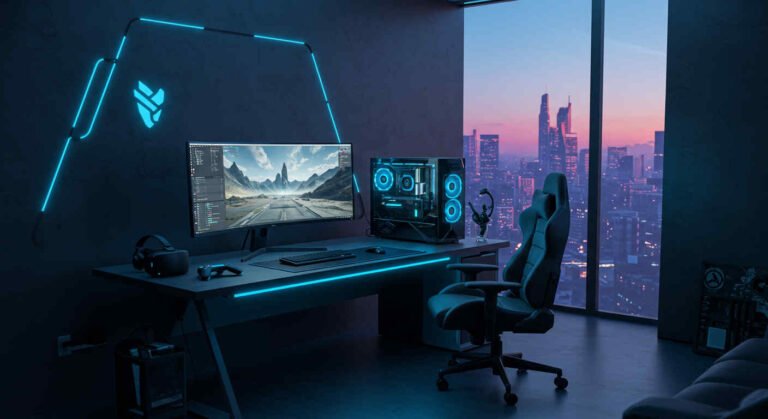Spatial Computing: The Future of Gaming and Design Unveiled

Table of Contents
Hey, folks! Strap in tight, because we’re about to blast off into the crazy world of spatial computing. It’s 2025, and reality’s getting a makeover so wild it’s like someone smeared Vaseline on life’s lens. Spatial computing—you know, that mash-up of augmented reality (AR), virtual reality (VR), and 3D wizardry—is kicking up dust like a bull in a china shop.
It’s not just techie talk anymore; it’s the real McCoy, flipping gaming and design upside down. So, grab a soda, plop down, and let’s chew the fat about this game-changer—the future’s here, and it’s waving a headset like a flag.
Stepping Into a Dream
Close your eyes and picture this: you slap on a headset, and—bam!—your dingy apartment’s gone. Instead, you’re ducking arrows in a forest so alive you’d swear the pine needles tickle your nose.
That’s spatial computing in a nutshell. It’s like the world cracked open a toy chest and handed us a golden ticket to mix real and fake into one big, gooey mess. Gaming’s riding this wave hard—you’re not just twiddling thumbs anymore; you’re there, slashing at dragons or zooming through galaxies like you own the joint.
Take Skyward Clash, the VR darling of 2025. You pop on your gear, and whoosh, you’re a sky pirate swinging from airship to airship. The clouds puff up like cotton candy, and the wind roars in your ears like a ticked-off lion. It’s not just a game—it’s a full-on adventure, slicker than a greased weasel.
These headsets are so light now, they’re barely a whisper on your head, and the tracking’s sharper than a tack. Big-name studios are all over it like flies on honey, but don’t sleep on the small fries either—they’re cooking up surprises that’ll knock your boots off.
Case in point: Whispering Hollow, a scrappy little VR tale from a garage crew. You’re wandering a ghost town, and the wind moans like it’s spilling gossip, boards creaking underfoot with every step. It’s bare-bones but hits like a freight train, showing this tech’s got room for everyone with a spark. My buddy’s kid brother tried it—13 years old, skinny as a rail—and he’s hooked, jabbering about ghosts for days. Thing is, it’s not just about dodging reality—it’s about twisting it into something new.
Those same tricks tossing you into pirate battles are creeping into design, too, letting folks build castles in the air that shimmer like a mirage, teasing a tomorrow where dreams strut right out of your skull.
Design’s Shiny New Toy
Now, let’s flip the script and talk design. Imagine a frazzled architect, sipping lukewarm coffee, staring at a laptop. Old-school, they’d doodle on napkins or wrestle with software that’s slower than molasses. But in 2025? They toss on an AR rig, and—poof!—a tower sprouts right there in the break room. They stroll around it, nudge the doors wider, or yank the spire tall as a sequoia, all with a wiggle of their fingers. It’s like the blueprints are chatting back, begging for a little flair.
This ain’t no fairy tale—it’s happening now. Check out DreamForge, a hot tool rolling out this year. Designers whip up 3D models that breathe, practically pulsing with life. You’re crafting a beach shack one second, then bam, you’re inside, toes curling in virtual sand as waves crash like a drum solo. It’s nuttier than a fruitcake, and businesses are scarfing it down. Why? It’s a money-saver—real-world mock-ups bleed cash like a stuck pig, but this? It’s pennies on the dollar.
Take my pal Larry—he’s a hobbyist, not some hotshot pro. He snagged a budget AR kit to redo his garage. No kidding, he’s sketching shelves and a workbench, tweaking ‘em like a kid with a coloring book, and—zing!—it’s spot-on, all for less than a tank of gas. Last weekend, he showed me: we’re standing there, goggles on, and he’s grinning like he’s won the lottery, pointing at a virtual dartboard he “hung” on the wall. It’s like the tech’s tossing you a lifeline, no blueprints needed. But hold up—it’s not all smooth sailing.
Glitches sneak in like uninvited guests, turning your masterpiece into a scrambled mess. My pal Sue was demoing a virtual kitchen when it froze—suddenly, she’s gesturing at a blob like a mime gone rogue. It’s a hiccup, sure, but it’s whispering of bigger storms—and bigger wins—down the road.
The Guts of the Beast

So, what’s fueling this magic show? Let’s peek under the hood. Spatial computing’s got a toolbox stuffed to the brim. Hardware’s the star—headsets like the LunaPulse 3, hitting shelves in 2025, are lighter than a sigh and flash screens so clear the colors practically wink at you. Then there’s the sensors, zipping around like caffeinated squirrels, catching every blink or twitch you throw their way. It’s like they’re mind-readers, keeping the whole shebang humming like a well-oiled machine.
The cameras are sneaky little devils too—scouting your space like hawks on the hunt. They clock your lamp, your cat, even that crusty sock under the couch, weaving it all into the mix. Ever wonder why your AR ninja doesn’t trip over your ottoman? That’s those peepers mapping every inch, turning your pad into a playground faster than you can say “jackpot.” I tried tweaking my setup once—moved a chair mid-game, and the camera caught it like a ninja, adjusting on the fly. It’s a juggling act, and they’re tossing pins like circus pros.
Software’s the quiet MVP, though. Tools like SparkVibe and DreamCore are the wizards behind the curtain, spinning worlds so real you’d bet your boots on it. They’re purring along in 2025, juiced up by AI sidekicks that tweak shadows or polish edges faster than you can blink. Imagine you’re gaming, and the moon rises, spilling silver across a lake like spilled paint—that’s AI flexing its muscles, brushing up the scene like an artist on a roll.
My nephew messed with it—set up a virtual campfire that crackled and popped, smoke curling like a lazy snake. It’s a dream team, dishing out rides so smooth you’d think the stars aligned just for you.
Here’s the catch, though: this juice comes with a shadow. The best gear’s still steep—think “rob a bank” steep. Budget options are sprouting like weeds, but they’re not the whole enchilada. My cousin Mike nabbed a cheap set—loves it, but it conks out mid-battle, leaving him staring at a blank wall like a lost puppy. I gave it a whirl too; halfway through a dogfight, it stuttered—talk about a buzzkill! It’s a carrot on a stick, tempting but tricky. Still, prices are dropping quicker than a hot potato, so maybe soon we’ll all be in on the party.
Gaming’s Wild Ride
Back to gaming—because, let’s face it, that’s the juicy bit. Spatial computing’s turning couch potatoes into trailblazers, and 2025’s lineup’s proof in the pudding. Heard of Timber Legends? It’s a VR riot where you’re a lumberjack leaping through treetops, axe thwacking like a heartbeat. The leaves rustle like they’re spilling tea, and the ground shakes when you land—thud!—like a giant’s stomp. It’s so real you’d swear sap’s dripping down your shirt.
Or try Street Blitz, an AR blast that turns your block into a speedway. You’re weaving past mailboxes, engine growling like a bear with a bellyache, laughing as you skid around the trash cans.
My buddy Tom gave it a spin at my place—next thing I know, he’s hollering, “Heads up!” as he dodges my couch like it’s a roadblock. I’m doubled over, but he’s in his own world, grinning like a Cheshire cat. Last week, I joined him—racing through my kitchen, I clipped the fridge and yelped like a pup, but man, the thrill’s worth it. These games aren’t just a hoot—they’re a peek at a future where your turf’s the turf, alive and kicking.
How about Shadow Reef? It’s a VR plunge into a sunken ship, water gurgling like a gossiping brook, fish darting past like shy kids at a dance. You’re gripping a lantern, pulse racing as something huge looms—boom, boom, boom—in the dark. My sister tried it—jumped a foot when a shark zipped by, swearing she felt the wake.
It’s a chill-down-your-spine thrill, sticking like gum on a shoe. Funny thing is, amid all the flash, it’s the quiet bits that grab you—like in Skyward Clash, staring at a galaxy swirling like a cosmic stew, mouth hanging open. It’s not the chaos; it’s the hush that smacks you silly. Who’d guess zeros and ones could tug your heartstrings?
Design’s Fresh Canvas
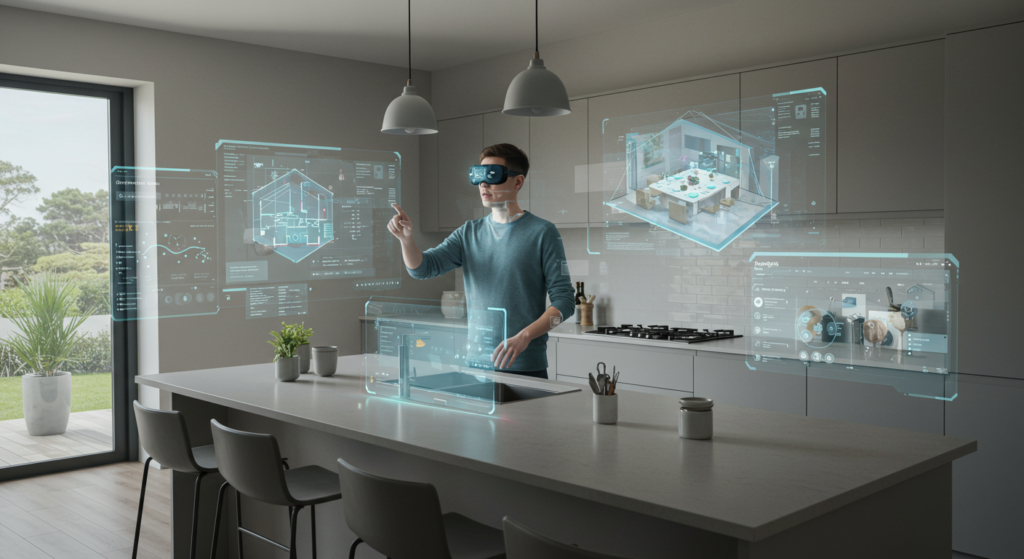
Designers are hopping on this train too—it’s their new playground, and they’re digging in like kids in mud. Interior folks are using AR to plop virtual lamps into real corners—zap, there’s a chandelier where your dog usually snoozes.
Clients peek through their screens, shrugging, “Eh, make it red,” without breaking a sweat. My neighbor Jen’s a designer—she showed a client a whole living room setup last week, flipping styles like pancakes, all from her kitchen table. She even tossed in a fake fireplace—crackling away, warming up the vibe like a hug. It’s smoother than butter, saving time and tears.
For the heavy hitters—think car buffs or city dreamers—it’s a goldmine. Picture sketching a truck in 3D, then climbing in to rev it up, engine purring like a happy cat. You twist the wheel, tweak the seats, and—vroom!—it’s rolling, all before a bolt’s turned. Or mapping a town, tiny folks bustling like bees in a hive, streets glowing like a neon sign. I caught a demo once—little shops blooming, buses humming, all alive like a dollhouse on a sugar rush.
My jaw dropped when a virtual kid waved at me—creepy, but cool. It’s a sneak peek at tomorrow, letting you test the waters before the tide rolls in. Sure, it’s spooky how real it feels, but that’s the spice—always teasing what’s around the bend.
Waves Everywhere
Zoom out a sec—spatial computing’s not just for gamers and doodlers; it’s splashing everywhere. Schools are all in—kids are slicing virtual lizards instead of the slimy real deal (yuck, but neat). Picture a science class where you’re shrunk down, strolling through a cell, organelles buzzing like a factory floor. My niece tried it—came home jabbering about DNA like it was her new best friend, eyes big as saucers. Beats the snooze-fest I had in school, that’s for darn sure—she’s hooked, and her teacher’s over the moon.
Docs are at it too, rehearsing operations in VR without the gore. A nurse pal told me she practiced a knee fix last month—nailed it in the real deal, cool as a cucumber. She said it’s like having a cheat code—every move’s locked in before the scalpel hits.
Even your grandpa might jump in, touring a digital London from his recliner, Big Ben chiming like a wake-up call. My old man tried it—grumbled at first, but next thing I know, he’s sipping coffee, gawking at Westminster like a tourist. It’s like the planet’s splitting wide, tossing goodies every which way.
But not everyone’s cheering—some grumble it’s too far-out, like a movie gone haywire. My dad’s one; he mutters, “What’s wrong with plain old life?” Others fret it’ll chain us to gadgets, faces buried in screens like moles in dirt. I get it—after a VR marathon, my backyard felt flat as a pancake, like it’d lost its zip. There’s a whisper of worry we’ll drift too far, lost in a shiny bubble while the real world spins on without us. It’s a dance on a razor’s edge, juggling the dazzle with keeping it real.
What’s Next?
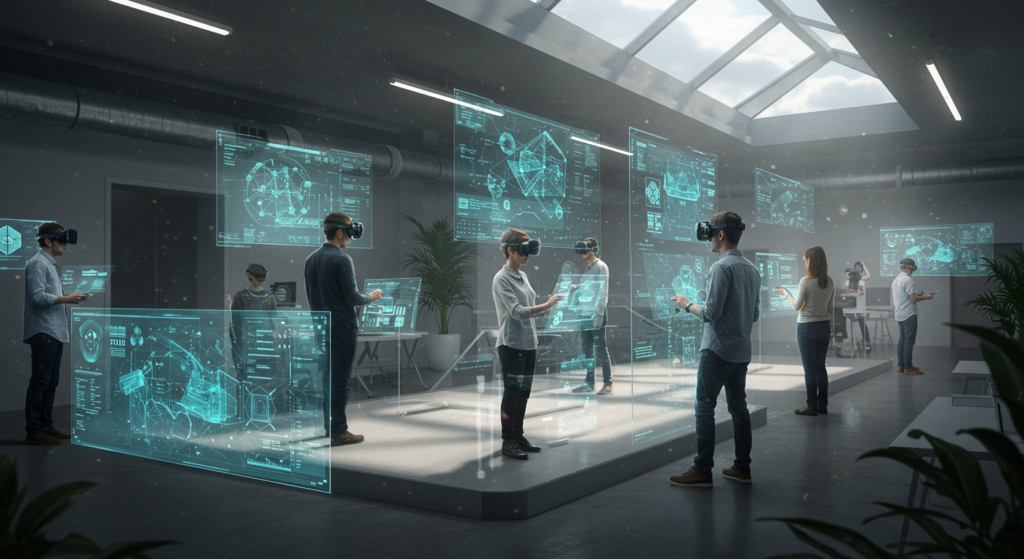
So, where’s this rollercoaster headed? Hang on, ‘cause 2025’s just the warm-up act. Headsets’ll shrink tinier than a thimble, batteries lasting longer than a winter nap, and visuals so sharp you’ll taste the virtual coffee.
Devs are dreaming big—games where rain patters on your skin or designs you can squeeze like dough. Imagine crafting a virtual birdhouse, wood splintering—crack!—under your hands, then watching it soar in a digital sky. My buddy’s already scheming—he wants a game where you fish, feeling the tug of a virtual trout. It’s a freight train picking up steam, and we’re all aboard.
The real gem? It’s tying us up tight. Multiplayer VR’s popping—picture raiding a dungeon with your cousin in Texas, cackling like you’re shoulder to shoulder. I played a VR tag game with a friend in Seattle last night—darting, dodging, howling like loons.
She tagged me through a virtual bush, and I’m yelling, “No fair!” like we’re kids again—it’s like she’s here, not a coast away. Designers are huddling in virtual workshops, ideas bouncing like ping-pong balls. I peeked at one—folks from three continents tweaking a bridge, laughing like old pals. It’s a lifeline across oceans, shrinking the globe till it fits in your pocket. Tech’s the muscle, but the heartbeat’s pure gold—a promise of togetherness in a wired-up whirlwind.
Rough Patches
Not gonna sugarcoat it—there’s potholes aplenty. The cost’s a gut punch for some, and not every setup’s a smooth operator. Lag can slam you like a brick wall, yanking the fun out faster than a yanked plug. My coworker got a bargain rig—half the time, he’s growling at freezes like a bear with a thorn. I borrowed it once—ten minutes in, it’s chugging like an old jalopy, and I’m ready to chuck it. Motion sickness is a buzzkill too—some folks stagger off like they’ve spun on a merry-go-round too long. Fixes are tiptoeing in, though, slow but sure, like sunrise creeping over the hills.
Accessibility’s a pickle too—it’s still a VIP club, with premium gear for the big spenders. But cheaper stuff’s blooming, and outfits are scrambling to open the gates wide. I spotted a $75 AR kit at a flea market—rough around the edges, but it works. My nephew’s teacher got one for class—kids are passing it around, giggling like it’s Christmas. It’s a simmer, not a boil, but the pot’s heating up. Another year or two, and this could be as everyday as your flip-flops, humming in every nook and cranny.
Why It’s a Big Deal
So, why give a hoot? ‘Cause spatial computing’s not just a gizmo—it’s a shake-up. It’s rewriting the playbook for fun and creation, handing gamers epic quests and designers a canvas that talks back. It’s a firecracker, lighting up shadows we didn’t even see. My buddy’s kid, eight years old, built a virtual fort last week—beaming like he’d struck oil, he dragged me in to “defend” it from pirates. That’s the juice: it’s waking up the dreamer in us all, young or creaky.
Remember your first joystick or crayon sketch? That giddy buzz? This tech’s hauling it back, loud and proud. It’s a passport to anywhere, a shove past the humdrum into something grand. Yeah, it’s got warts—like a jewel still rough in the stone—but that’s the rush. We’re front-row to tomorrow, watching it spark and sputter, growling like a beast ready to leap. It’s a call to jump in, to grab the reins and ride the wave wherever it crashes.
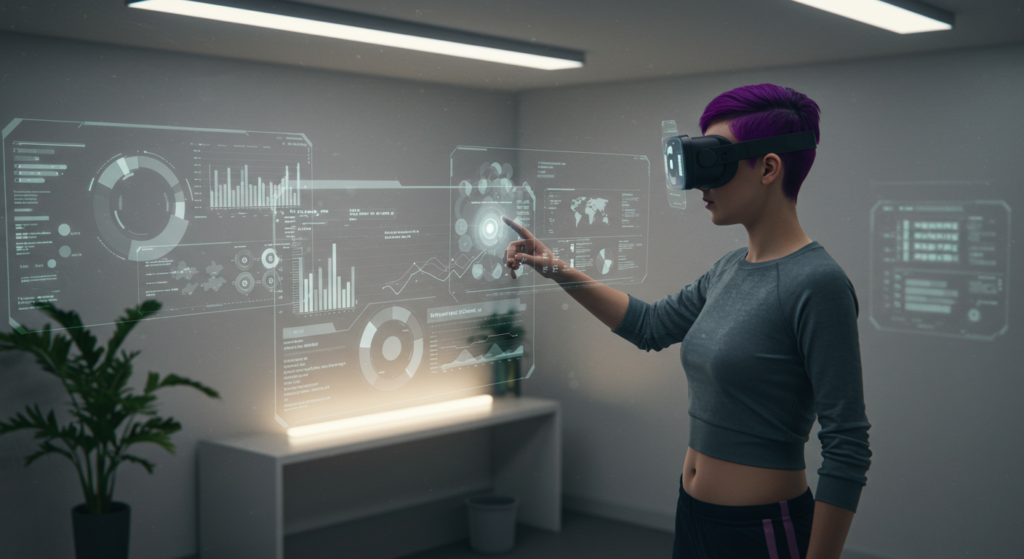
Tying the Bow
Alright, let’s bring it home. Spatial computing’s the hot ticket in 2025, spinning heads faster than a gossip mill. Gaming’s a blast—think racing through your den or sailing the stars like a hotshot. Design’s shining too, with creators sculpting worlds that hum and buzz. It’s raw, it’s rowdy, and it’s just getting started. My niece says it’s “like magic, but cooler,” and she’s not wrong—it’s a spell we’re all falling under.
The path’s got bumps—pricey toys, pesky glitches—but the dawn’s breaking bright. This tech’s a bard, spinning yarns of what could be if we grab the reins. Next time that headset hums or a 3D doodle twirls, perk up. It’s not just static—it’s the future nudging you, whispering, “You in?” And buddy, you don’t wanna sit this one out.
See this good external article: https://www.pcmag.com/how-to/what-is-spatial-computing-a-basic-explainer
See this another good article in our blog: https://techforgewave.com/isaac-newton-the-gravity-groove/
